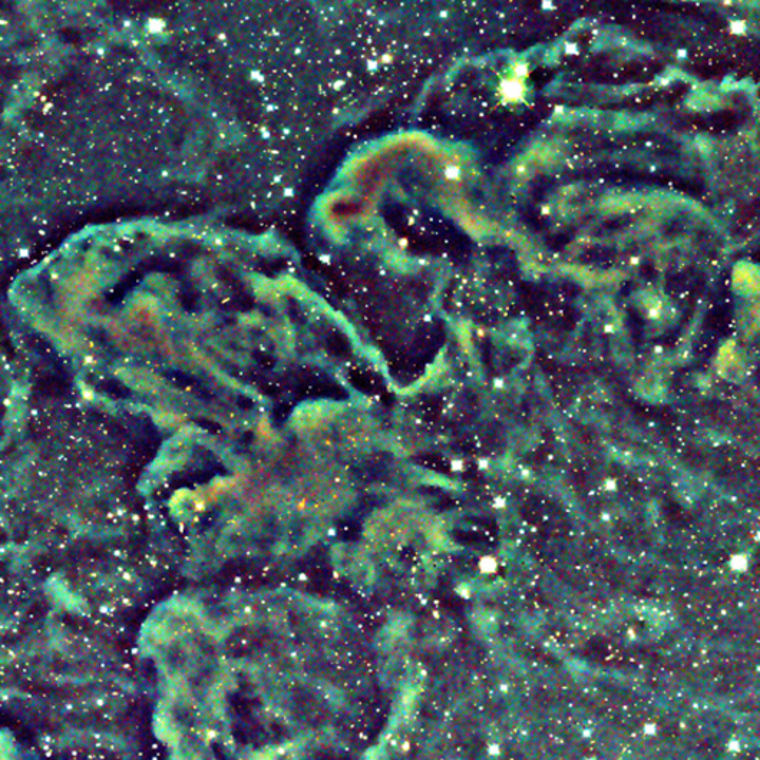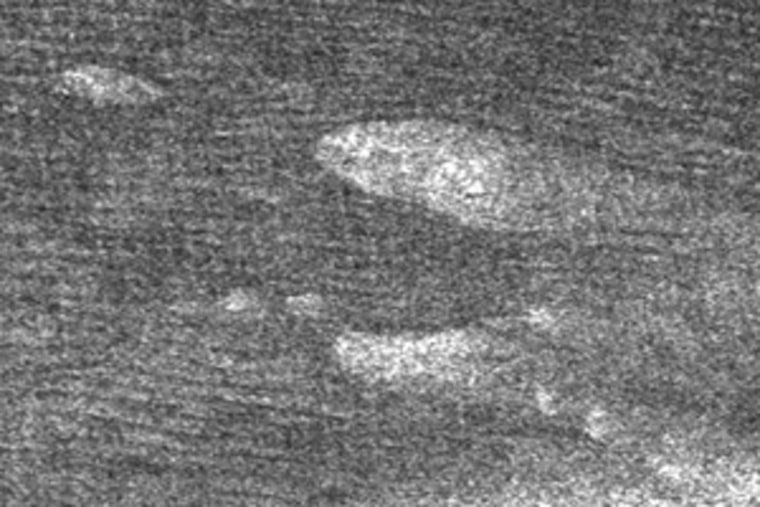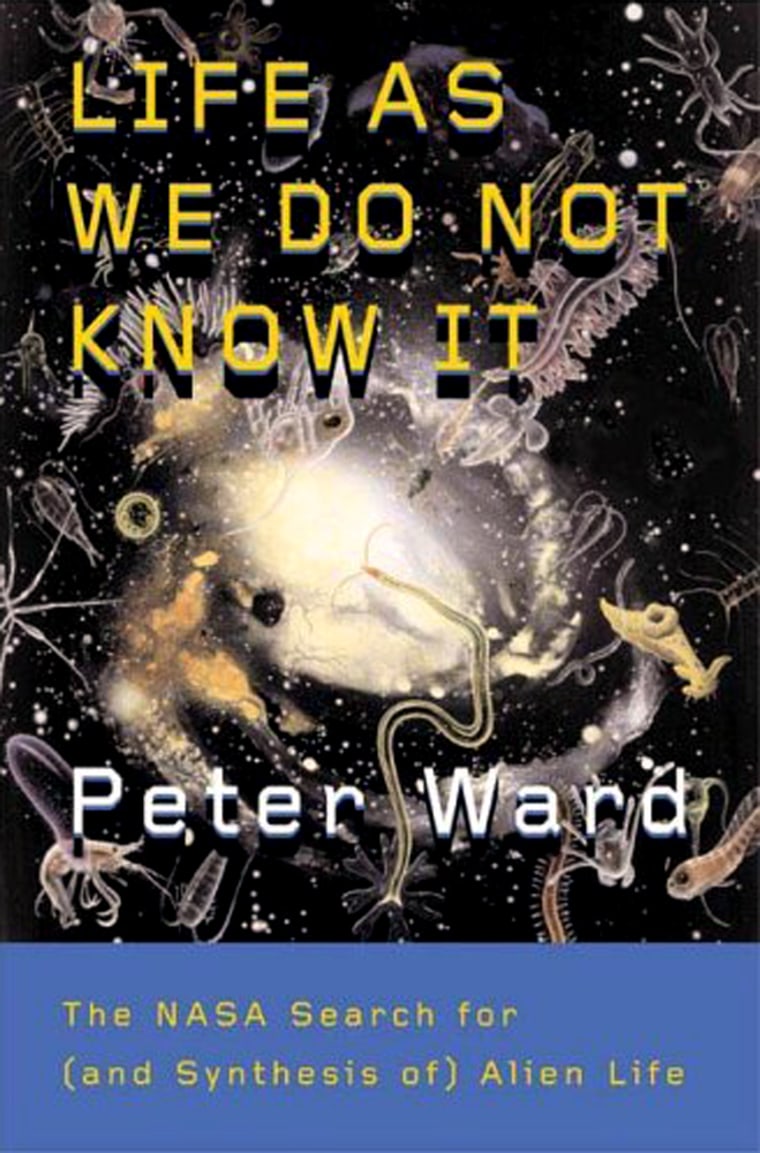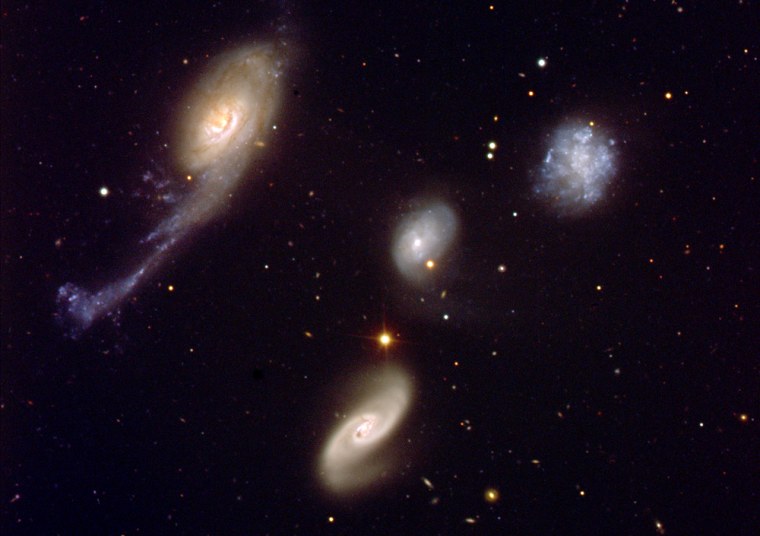• Nov. 4, 2005 |
The Fab Four of galaxies: If galaxies were rock stars, some would be solo acts, and others — like our own Milky Way galaxy — would have a backup ensemble. But the flashiest galaxies are usually members of supergroups, and that's certainly the case for Robert's Quartet, the subject of a newly released snapshot from the European Southern Observatory's Very Large Telescope in Chile.
This grouping makes the Rolling Stones look like a boy band: The quartet in the constellation Phoenix was discovered by English astronomer John Herschel in the 1830s — and because the galaxies are 160 million light-years away, the light we see today was emitted when dinosaurs walked the earth (and I don't mean Keith Richards).
Like most groups of galaxies as well as rock bands, the members of Robert's Quartet are a disruptive lot. NGC 92, the leftmost galaxy, has had one of its spiral arms stretched to a length of 100,000 light-years due to gravitational interactions from the other galaxies.
The interactions have also sparked more than 200 star-forming regions in NGC 92 alone. The irregular galaxy at upper right, NGC 87, has 56 more such regions. The other two, NGC 88 and NGC 89 (center and lower center, respectively), also show signs of heightened star formation. "The sisters clearly belong to a perturbed family," the ESO says in today's image advisory, which makes it sound as if Robert's Quartet is a girl group.
Astronomers named Robert's Quartet after Robert Freedman, who helped out with the Catalogue of Southern Peculiar Galaxies and Associations. "The astronomers clearly had a very good sense of humor," the ESO says, "as the catalog also contains a system of galaxies called Wendy (for Wendy Freedman) and another called the Conjugal Galaxy!"
Australian astronomer Mike Kerr traced the mystery behind the names. It might help to know that one of the galaxy-naming astronomers was Barry Madore, the husband of astronomer Wendy Freedman. In fact, yet another galactic group is known as "Madore's Monster."
Because galactic groups like Robert's Quartet are packed so close together, they serve as "excellent laboratories for the study of galaxy interactions and their effects, in particular on the formation of stars," the ESO says. For more great views of compact groups, check out the Hubble Space Telescope's picture of Hickson Compact Group 87, observations of Stephan's Quintet from Hubble and the Kitt Peak National Observatory, and the Subaru Telescope's rendition of Hickson Compact Group 40.
• Nov. 4, 2005 |
Not-so-empty space: Outer space is mind-bogglingly big, and it also seems mind-bogglingly empty. But researchers at the Harvard-Smithsonian Center for Astrophysics have found that stars can illuminate the diffuse clouds of dust and gas that surround them, just as city lights cause a glow in nighttime fog on Earth. You just have to look really, really hard.

Near-infrared pictures of interstellar "cloudshine" were obtained during a survey of star-forming regions known as the Coordinated Molecular Probe Line Extinction Thermal Emission survey, or COMPLETE. The imagery represents "the most spectacular evidence of cloudshine to date," Alyssa Goodman of the Center for Astrophysics said in a news release issued Thursday.
"We can now see the structure of gigantic star-forming regions over vast distances with a resolution 50 times better than before," she said. "This technique will revolutionize the way we map stellar birthplaces."
Goodman and Harvard's Jonathan Foster have submitted their observations to The Astrophysical Journal Letters for publication, and other researchers have written up a separate paper on the theory of cloudshine.
• Nov. 4, 2005 |
Weekend field trips on the World Wide Web:
•
•
•
•
• Nov. 3, 2005 |
Watch the skies: Just because you missed last weekend's close encounter with Mars, don't think that the show is over.
There's still plenty of prime-time viewing for the Red Planet, including Monday's opposition, when Earth comes directly between Mars and the sun. Each night, Mars will be higher in the sky at a given time — and the higher Mars rises above the horizon, the easier it is for small telescopes to pick up details on the planet's disk.
Last weekend, I couldn't see all that much detail through my 8-inch reflector, which I set up in a mountain tourist spot. But I did see a nice smattering of meteors, and it turns out that this is prime time for potentially spectacular shooting stars. This year's Taurid meteor shower is shaping up as a good one for seeing blazing fireballs in the sky, and the Taurids are just now reaching their peak.
That makes two good reasons for watching the night sky this weekend. To maximize your viewing pleasure, find a place with clear, crisp skies, far away from city lights. For suggestions on where to go, you can try out the DarkSky stargazing mapper from the International Dark-Sky Association (although a flesh-and-blood astronomer might be a more reliable source).
The viewing gets better if you stay up late: For Mars, the prime telescope time comes just around midnight, when the butterscotch-colored disk is near the zenith. After midnight is the best time for spotting meteors, because that's when Earth is turning into the showers of tiny particles that spark those shooting stars.
The Taurids will appear to radiate from a point in the constellation Taurus — close to Mars as well as the Pleiades, as shown in this NASA star map. But don't focus solely on that spot: Meteors can appear anywhere in the night sky.
Later in the month, the Leonid meteors will be making their appearance, with potential peaks on Nov. 17 and 21. This year isn't expected to be a great year for the Leonids, because of the glare from a bright moon. Nevertheless, it's worth staying up late, for meteors as well as Mars. If you're looking for company, find your local astronomical society on this master list and make contact.
• Nov. 3, 2005 |
El árbol de la vida ... extraterrestre: Heber Rizzo of Ciudad de la Costa, Uruguay, has graciously translated this week's posting on paleontologist Peter Ward's "tree of alien life" into Spanish for the . "Astroseti.org is a nonprofit organization supported by volunteer translators like me, and its goal is to spread scientific knowledge among Spanish-speaking people," Rizzo explained. Muchas gracias!
• Nov. 3, 2005 |
Scientific smorgasbord on the World Wide Web:
•
•
•
•
• Nov. 2, 2005 |
The dunes of Titan: The latest pictures of Saturn's moon Titan, snapped by the Cassini spacecraft during last Friday's flyby, reveal many more of the mysterious "cat scratches" that have been seen in earlier radar imagery.
The patterned ridges look as if they were left behind by someone raking sand around the rocks in a Zen garden. In the new batch of pictures, the ridges curve around bright protuberances that stick up like the rocks in the sand.

As described in Tuesday's image advisory, the latest radar imagery confirms the view that the "cat scratches" are wind-shaped dunes, perhaps composed of flecks of water ice or hydrocarbon particles.
In addition to the cat scratches, Cassini's synthetic aperture radar spotted other curiosities on Titan, whose surface is typically hidden from view due to a thick, smoggy atmosphere. Fortunately, Cassini has the radar mapper as well as a filter-equipped camera — both of which can cut through the haze.
The latest radar views show tectonic features — high ridges running over lengths of more than 60 miles (100 kilometers), again with cat scratches in the surrounding plain. Another picture reveals dark, snaking channels that may have been carved by liquid methane.
During the flyby, Cassini came as close as 841 miles (1,353 kilometers) from the surface, and was even able to take pictures of the site where its Huygens piggyback probe landed almost 10 months earlier. The resolution isn't nearly good enough to spot the Huygens lander itself, but the imagery from above should give scientists a better idea of what they were looking at in the amazing images taken during and after Huygens' descent.
The Cassini imaging team's Web site has more raw imagery from the Titan flyby, and there's still more to come: A close encounter with another Saturnian moon, Rhea, is coming up on Nov. 26, and the next close flyby of Titan will be on Dec. 26. To keep track of what's going on, check out NASA's Cassini Web site, the Planetary Society's Saturn guide and SpaceRef's Saturn Today site.
• Nov. 2, 2005 |
Sex and science on the World Wide Web:
•
•
•
•
• Nov. 1, 2005 |
The tree of alien life: Paleontologist Peter Ward wants to trash the tree of life — at least the time-honored tree that we all learned about in biology class.
In his latest book, “Life as We Do Not Know It,” Ward notes that scientists are already fiddling with genetic code to create what you could arguably call alien organisms, and he proposes a grander tree — or a forest of trees — for those aliens as well as viruses, non-DNA life and silicon-carbon extraterrestrials.
"This sets the house up for admitting all these aliens," said Ward, a University of Washington professor who delves into issues surrounding ancient life as well as future life.
Today's most widely accepted tree of life has three top levels, or domains: bacteria and archaea (two strains of one-celled organisms) and eukaryotes (all multicellular organisms, including us). But Ward argues that such a tree lacks branches for entities that really should be considered part of life's spectrum, including:
- Viruses: Biologists tend to leave viruses out of the tree altogether, arguing that they really aren't living creatures but merely bits of protein and nucleic acid that hack into cells to replicate themselves. Ward, however, contends that viruses are just as alive as more complex cellular parasites.
- The RNA world: Biochemists believe that today's DNA-based organisms started out billions of years ago as RNA-based life, or even as smaller assemblages of self-replicating molecules in lipid membranes. Today, we don't see any extant RNA-based life, but Ward argues that we don't see any dinosaurs either, and yet they are included as extinct branches of life's tree. Moreover, some researchers are working to resurrect the RNA world. "The first artificial life will be RNA life," Ward predicted.
- Synthetic organisms: All naturally occurring terrestrial organisms use 20 amino acids, but scientists have modified bacteria to use extra amino acids not typically found in nature. Other researchers are trying to pare down life's genetic code to the bare minimum. Ward insists that such substantially modified organisms should have their own "alien" classification.
- Life elsewhere: Right now this is just a hypothetical concern, but it's conceivable that life could be discovered beneath the Martian surface, or under the ice of Europa, or within Titan's slush. Ward speculates that extraterrestrial life could be based on silicon as well as carbon, and use ammonia or even liquid nitrogen as a solvent rather than water.
Ward called for "jacking up" the traditional tree by a couple of levels: First, he'd group the three current DNA-based domains, along with encapsulated DNA viruses, under an overarching category known as the terroan dominion. Then he'd create another dominion, which he calls "ribosa," for present and past RNA life, including RNA viruses. Other dominions could be created to cover life on Earth that is not based on DNA or RNA.
"If we're dealing with life that's way different from our kind of life, there's a very good chance that we'll miss it," Ward told me. "Actually, there's a dirty little secret that's been going on for 20 years. ... In reality, we do not know if there's non-DNA life still on Earth, because the way in which we test for life on Earth is to give it a DNA paternity test."

All those earthly dominions would comprise an even broader classification called an "arborea," which takes in life that does not mix with that of other planets. A separate arborea would be set up for every planet where life is found.
Although the book is just coming out, Ward has been floating these ideas in front of fellow scientists for more than a year. The reviews have been mixed, he said: Some experts said the scheme is unnecessary — particularly since the current categories can handle even exotic earthly life, and no extraterrestrial life has been found yet. Others wondered why they didn't think of the idea first.
"I hope people will wake up and realize this is a whole new biology," Ward said in a University of Washington news release on the book. "There's going to be a zoo of aliens on Earth in the next two decades, just from what we make."
This isn't Ward's first foray into the meaning of life, on and off our home planet. He's also the co-author of "Rare Earth," which suggests that although microbial life may be common elsewhere in the universe, intelligent life is probably extremely rare. That last point has been picked up even by intelligent-design advocates, to claim that Earth is a "privileged planet" in the cosmos.
"I've never yet met any intelligent-designer who actually read 'Rare Earth,'" Ward told me. "They all hear about it, and just assume that we say that life is unique to Earth. They've never even taken the trouble to read the two sentences of the 'Rare Earth' hypothesis — that life ought to be everywhere, with complex life at much lower frequency. It's 'rare' in terms of animals, dummies!"
For more of Ward's musings, check out his reflections on future evolution as well as Wikipedia's take on the "Rare Earth" hypothesis.
• Nov. 1, 2005 |
Must-see science on the World Wide Web:
•
•
• (via Posthuman Blues)
•
Looking for older items? Check the . Share your perspective on cosmic subjects with . If you link to this page, you can use or as the address. MSNBC is not responsible for the content of Internet links.
